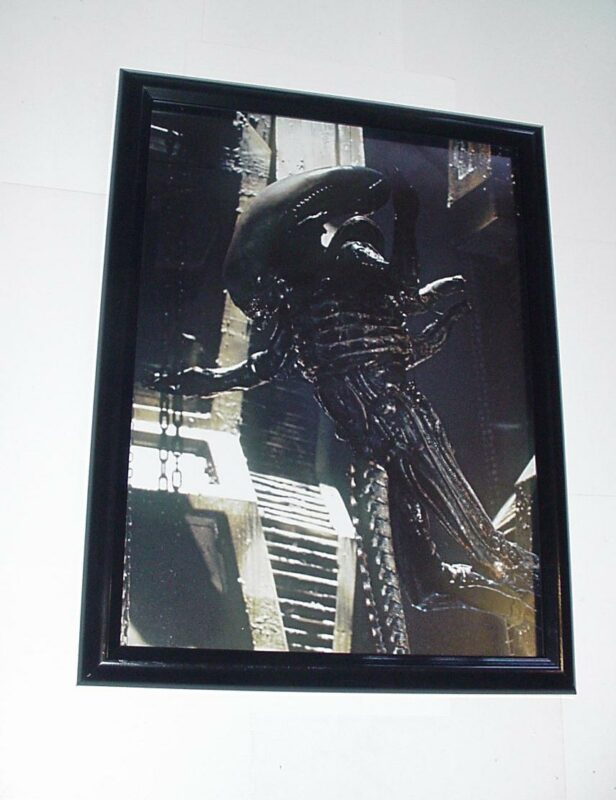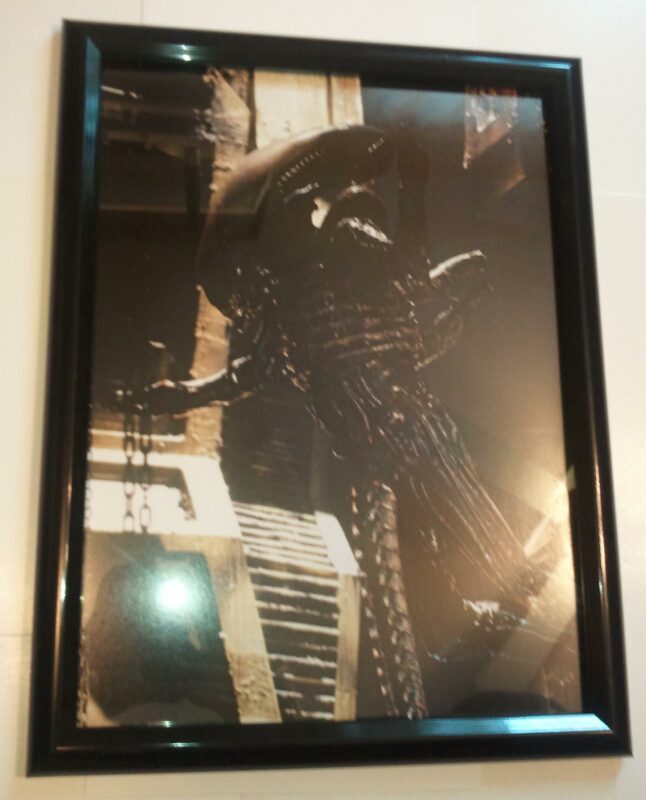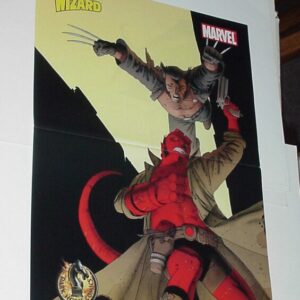Aliens Poster #27 FRAMED Alien Movie Bolaji Badejo H.R. Giger Creation
$74.99
Description
Giger’s Alien, as portrayed by Bolaji Badejo in Ridley Scott’s 1979 film Alien. Bolaji Badejo as The Alien- Nigerian Badejo, while a 26-year-old design student, was discovered in a bar by a member of the casting team, who put him in touch with Ridley Scott. Scott believed that Badejo, at 6 feet 10 inches (208 cm) (7ft. inside the costume) and with a slender frame, could portray the Alien and look as if his arms and legs were too long to be real, creating the illusion that there could not possibly be a human being inside the costume. Stuntmen Eddie Powell and Roy Scammell also portrayed the Alien in some scenes.
Alien is a 1979 science-fiction horror film directed by Ridley Scott, and starring Tom Skerritt, Sigourney Weaver, Veronica Cartwright, Harry Dean Stanton, John Hurt, Ian Holm and Yaphet Kotto. The film’s title refers to a highly aggressive extraterrestrial creature that stalks and kills the crew of a spaceship. Dan O’Bannon wrote the screenplay from a story he wrote with Ronald Shusett, drawing influence from previous works of science fiction and horror. The film was produced by Gordon Carroll, David Giler and Walter Hill through their Brandywine Productions and distributed by 20th Century Fox. Giler and Hill made revisions and additions to the script. Shusett was executive producer. The eponymous Alien and its accompanying elements were designed by Swiss surrealist artist H. R. Giger, while concept artists Ron Cobb and Chris Foss designed the human aspects of the film.
Alien received both critical acclaim and box office success, receiving an Academy Award for Best Visual Effects, Saturn Awards for Best Science Fiction Film, Best Direction for Scott, and Best Supporting Actress for Cartwright, and a Hugo Award for Best Dramatic Presentation, along with numerous other award nominations. It has remained highly praised in subsequent decades, being inducted into the National Film Registry of the Library of Congress in 2002 for historical preservation as a film which is “culturally, historically, or aesthetically significant”. In 2008, it was ranked as the seventh-best film in the science fiction genre by the American Film Institute, and as the 33rd greatest movie of all time by Empire magazine.
The success of Alien spawned a media franchise of novels, comic books, video games, and toys. It also launched Weaver’s acting career by providing her with her first lead role, and the story of her character Ripley’s encounters with the Alien creatures became the thematic thread that ran through the sequels Aliens (1986), Alien 3 (1992), and Alien Resurrection (1997).
The script for the 1979 film Alien was initially drafted by Dan O’Bannon and Ronald Shusett. Dan O’Bannon drafted an opening in which the crew of a mining ship are sent to investigate a mysterious message on an alien planet. He eventually settled on the threat being an alien creature; however, he could not conceive of an interesting way for it to get onto the ship. Inspired after waking from a dream, Shusett said, “I have an idea: the monster screws one of them,” planting its egg in his body, and then bursting out of his chest. Both realized the idea had never been done before, and it subsequently became the core of the film. “This is a movie about alien interspecies rape,” O’Bannon said on the documentary Alien Evolution, “That’s scary because it hits all of our buttons.” O’Bannon felt that the symbolism of “homosexual oral rape” was an effective means of discomforting male viewers.
After O’Bannon handed him a copy of Giger’s book Necronomicon, Scott immediately saw the potential for Giger’s designs, and chose Necronom IV, a print Giger completed in 1976, as the basis for the Alien’s design, citing its beauty and strong sexual overtones. That the creature could just as easily have been male or female was also a strong factor in the decision to use it. “It could just as easily f- you before it killed you”, said line producer Ivor Powell, “which made it all the more disconcerting.” Fox studios were initially wary of allowing Giger onto the project, saying that his works would be too disturbing for audiences, but eventually relented. Giger initially offered to completely design the Alien from scratch, but Scott mandated that he base his work on Necronom IV, saying that to start over from the beginning would be too time-consuming. Giger signed on to design the adult, egg and chest-burster forms, but ultimately also designed the alien planetoid LV-426 and the Space Jockey alien vessel.
Giger conceived the Alien as being vaguely human but a human in full armor, protected from all outside forces. He mandated that the creature have no eyes, because he felt that it made them much more frightening if you could not tell they were looking at you. Giger also gave the Alien’s mouth a second inner set of pharyngeal jaws located at the tip of a long, tongue-like proboscis which could extend rapidly for use as a weapon. His design for the creature was heavily influenced by an aesthetic he had created and termed biomechanical, a fusion of the organic and the mechanic. His mock-up of the Alien was created using parts from an old Rolls Royce car, rib bones and the vertebrae from a snake, molded with plasticine. The Alien’s animatronic head, which contained 900 moving parts, was designed and constructed by special effects designer Carlo Rambaldi. Giger and Rambaldi would both go on to win the 1980 Academy Award for Visual Effects for their design of the Alien.
Scott decided on the man-in-suit approach for creating the creature onscreen. Initially circus performers were tried, then multiple actors together in the same costume, but neither proved scary. Deciding that the creature would be scarier the closer it appeared to a human, Scott decided that a single, very tall, very thin man be used. Scott was inspired by a photograph of Leni Riefenstahl standing next to a 6’4″ Nubian. The casting director found 6’10” (2.08 m), rail-thin graphic designer Bolaji Badejo in a local pub. Badejo went to tai chi and mime classes to learn how to slow down his movements.
Giger’s design for the Alien evoked many contradictory sexual images. As critic Ximena Gallardo notes, the creature’s combination of sexually evocative physical and behavioral characteristics creates, “a nightmare vision of sex and death. It subdues and opens the male body to make it pregnant, and then explodes it in birth. In its adult form, the alien strikes its victims with a rigid phallic tongue that breaks through skin and bone. More than a phallus, however, the retractable tongue has its own set of snapping, metallic teeth that connects it to the castrating vagina dentata”.
Giger made several conceptual paintings of the adult Alien before crafting the final version. He sculpted the creature’s body using plasticine, incorporating pieces such as vertebrae from snakes and cooling tubes from a Rolls-Royce. The creature’s head was manufactured separately by Carlo Rambaldi, who had worked on the aliens in Close Encounters of the Third Kind. Rambaldi followed Giger’s designs closely, making some modifications in order to incorporate the moving parts which would animate the jaw and inner mouth. A system of hinges and cables was used to operate the creature’s rigid tongue, which protruded from the main mouth and had a second mouth at the tip of it with its own set of movable teeth. The final head had about nine hundred moving parts and points of articulation. Part of a human skull was used as the “face”, and was hidden under the smooth, translucent cover of the head. Rambaldi’s original Alien jaw is now on display in the Smithsonian Institution, while in April 2007 the original Alien suit was sold at auction. Copious amounts of K-Y Jelly were used to simulate saliva and to give the Alien an overall slimy appearance.
Frame is shrinkwrapped until time of purchase. Ships boxed with packing peanuts.
THE PERFECT GIFT!













